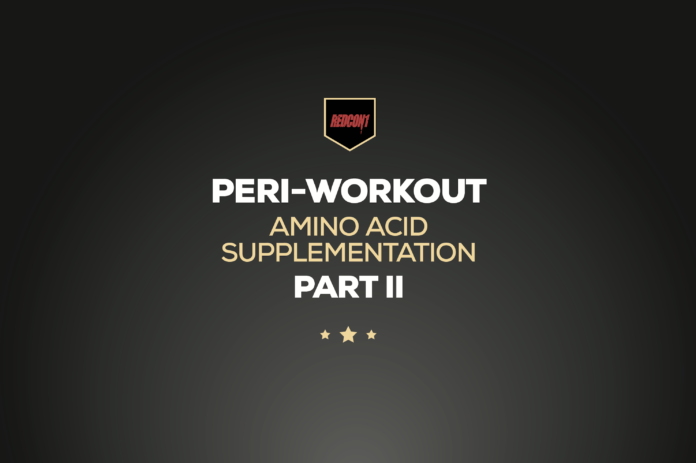
Now that a full comprehension of peri-workout nutrient timing is understood from the ISSN’s point of view, we can begin piecing parts of the puzzle together from other pieces of literature. Branched chain amino acids (BCAAs) constitute around 17% of skeletal muscle protein, around 33% of dietary essential amino acids (EAAs.) During resistance training, these are easily oxidized (2, 3.) This spiking of blood amino acid levels result in greater rates of muscle protein synthesis (MPS) as well as enhanced recovery factors, other enhanced growth factors, and enhanced performance of that session itself, taking full advantage over the increased sensitivity and enhanced partitioning happening (4, 5, 6, 7.)
Now that we understand why peri-workout nutrition is importance, the role and importance of amino acids and easily digestible proteins during this timeframe, as well as the benefits it can promote, we now need to look at the actual sources we have available to us. Although this article is titled “peri-workout amino acid supplementation”, it would not be complete if we did not discuss protein as a whole during this time period. First, we need to ensure digestion is optimized and that we are utilizing easily digested source. These sources are whole protein powders and amino acids. When discussing protein powders with digestion as the focus, we need to look into powders that are hydrolyzed are these are pre-digested forms that can not only supply every essential amino acid needed to maximally stimulate muscle protein synthesis, but can also have an increased insulin effect (8, 9.) When discussing amino acids, we need to look at the two that offer the most benefits, essential amino acids (EAAs) and branched chain amino acids (BCAAs.) EAAs are comprised of Methionine, Lysine, Phenylalanine, Threonine, Tryptophan, Leucine, Isoleucine, and Valine where as BCAAs are comprised of Leucine, Isoleucine, and Valine. EAA’s are called “essential” because the body cannot make them; they must be obtained from food and/or supplement sources. These will stimulate muscular growth, repair, produce cellular energy, and promote cellular repair particularly during periods of intense stress (10, 11.) Branched chain amino acids offer very similar benefits but as they only contain three of the essential amino acids needed to maximally stimulate muscle protein synthesis, you need to ensure there is no rate limiting amino acids keeping your from maximizing this process during this particular period in time. A major benefit of BCAA supplementation really comes down to its leucine content. Leucine plays an important role in muscle protein synthesis (with isoleucine inducing glucose uptake into cells.) Utilizing these during these periods also prevents any decline in serum BCAAs (12, 13, 14, 15, 16, 17, 18.)
With the amount of information all pointing towards a tremendous amount of benefits to consuming amino acid supplements peri-workout, it makes it pretty hard to argue. Utilizing hydrolyzed protein powders, EAAs, and BCAAs within the peri-workout timeframe will ensure you are optimizing the growing and recovery process.
References
1. International Society of Sports Nutrition position stand: nutrient timing. Kerksick, C., et al., J Int Soc Sports Nutr., 2008. (https://jissn.biomedcentral.com/articles/10.1186/1550-2783-5-17)
2. Nutraceutical effects of branched-chain amino acids on skeletal muscle. Shimomura, Y., et al., The Journal of nutrition, (2006.) (http://www.ncbi.nlm.nih.gov/pubmed/16424141)
3. Oral branched-chain amino acids decrease whole-body proteolysis. Ferrando, A.A., et al., JPEN. Journal of parenteral and enteral nutrition, (1995.) (http://www.ncbi.nlm.nih.gov/pubmed/7658600)
4. Rapid aminoacidemia enhances myofibrillar protein synthesis and anabolic intramuscular signaling responses after resistance exercise. West, D.W., et al., The American journal of clinical nutrition, (2011.) (http://www.ncbi.nlm.nih.gov/pubmed/21795443)
5. Ingestion of casein and whey proteins result in muscle anabolism after resistance exercise. Tipton, K.D., et al., Med Sci Sports Exerc, (2004.) (http://www.ncbi.nlm.nih.gov/entrez/query.fcgi?cmd=Retrieve&db=PubMed&dopt=Citation&list_uids=15570142)
6Ingestion of whey hydrolysate, casein, or soy protein isolate: effects on mixed muscle protein synthesis at rest and following resistance exercise in young men. Tang, J.E., et al., J Appl Physiol, (2009.) (http://www.ncbi.nlm.nih.gov/entrez/query.fcgi?cmd=Retrieve&db=PubMed&dopt=Citation&list_uids=1958996)
7. Enhanced amino acid sensitivity of myofbrillar protein synthesis persists for up to 24 h after resistance exercise in young men. Burd, N.A., et al., J Nutr, (2011.) (https://www.ncbi.nlm.nih.gov/pubmed/21289204)
8. Hydrolyzed dietary casein as compared with the intact protein reduces postprandial peripheral, but not whole-body, uptake of nitrogen in humans. Deglaire, A., et al., Am J Clin Nutr, (2009.) (https://www.ncbi.nlm.nih.gov/pubmed/19692493)
9. Ingestion of a protein hydrolysate is accompanied by an accelerated in vivo digestion and absorption rate when compared with its intact protein. Koopman, R., et al., Am J Clin Nutr, (2009.) (https://www.ncbi.nlm.nih.gov/pubmed/19474134)
10. Effect of protein/essential amino acids and resistance training on skeletal muscle hypertrophy: A case for whey protein. Hulmi, J. J., Lockwood, C. M., & Stout, J. R Nutrition & Metabolism. (2010.) (https://www.ncbi.nlm.nih.gov/pmc/articles/PMC2901380/)
11. Essential amino acids are primarily responsible for the amino acid stimulation of muscle protein anabolism in healthy elderly adults. Elena Volpi, Hisamine Kobayashi, Melinda Sheffield-Moore, Bettina Mittendorfer, Robert R Wolfe Am J Clin Nutr. (2011.) (https://www.ncbi.nlm.nih.gov/pubmed/12885705)
12. New therapeutic strategy for amino acid medicine: notable functions of branched chain amino acids as biological regulators. Fumiaki Yoshizawa.J Pharmacol Sci. (2012.) (https://www.ncbi.nlm.nih.gov/pubmed/22293293)
13. Exercise training increases branched-chain oxoacid dehydrogenase kinase content in human skeletal muscle. Krista R. Howarth, Kirsten A. Burgomaster, Stuart M. Phillips, Martin J. Gabala Am J Physiol Regul Integr Comp Physiol. (2007.) (https://www.ncbi.nlm.nih.gov/pubmed/17581840)
14. Leucine stimulates translation initiation in skeletal muscle of postabsorptive rats via a rapamycin-sensitive pathway. J. C. Anthony, F. Yoshizawa, T. G. Anthony, T. C. Vary, L. S. Jefferson, S. R. Kimball. J Nutr. (2000.) (https://www.ncbi.nlm.nih.gov/pubmed/11015466)
15. Rapamycin administration in humans blocks the contraction-induced increase in skeletal muscle protein synthesis. Micah J Drummond, Christopher S Fry, Erin L Glynn, Hans C Dreyer, Shaheen Dhanani, Kyle L Timmerman, Elena Volpi, Blake B Rasmussen. J Physiol. 2009 (https://www.ncbi.nlm.nih.gov/pubmed/19188252)
16. Branched-chain amino acids activate key enzymes in protein synthesis after physical exercise. Eva Blomstrand, Jörgen Eliasson, Håkan K. R. Karlsson, Rickard Köhnke
J Nutr. 2006 Jan (https://www.ncbi.nlm.nih.gov/pubmed/16365096)
17. Dreyer, H. C., Fujita, S., Cadenas, J. G., Chinkes, D. L., Volpi, E., & Rasmussen, B. B. (2006). Resistance exercise increases AMPK activity and reduces 4E-BP1 phosphorylation and protein synthesis in human skeletal muscle. The Journal of Physiology, 2006.
(https://www.ncbi.nlm.nih.gov/pmc/articles/PMC1890364/)
18. Resistance exercise increases muscle protein synthesis and translation of eukaryotic initiation factor 2Bepsilon mRNA in a mammalian target of rapamycin-dependent manner. Neil Kubica, Douglas R. Bolster, Peter A. Farrell, Scot R. Kimball, Leonard S. Jefferson. J Biol Chem. 2005 (https://www.ncbi.nlm.nih.gov/pubmed/15591312)


















